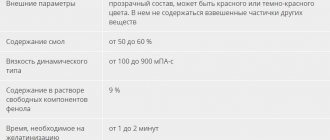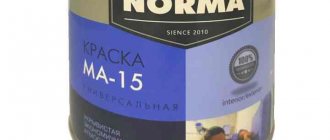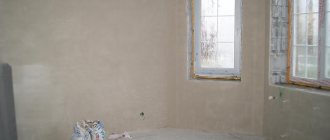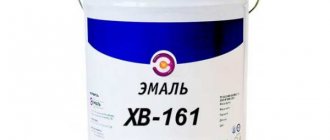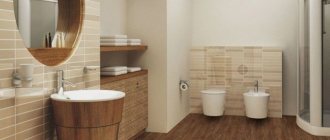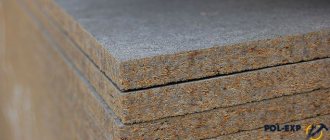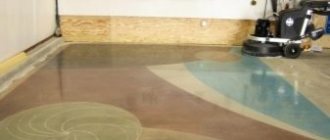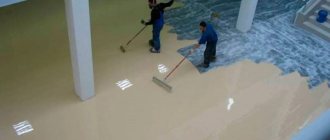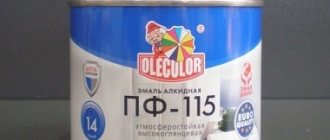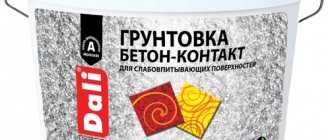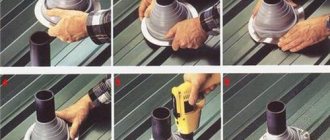The modern construction market is rapidly evolving, offering the user fundamentally new products. One of the latest innovations is glass-magnesite sheets (SML, novolist, stroylist, magnesite, glass magnesite). The material appeared relatively recently, however, it already confidently competes with such “veterans” as plasterboard and chipboard, surpassing them in a number of technical characteristics.
To better understand the functionality of LSU, it makes sense to familiarize yourself in more detail with the technical characteristics of the material.
Composition and structure of glass magnesite
Glass-magnesium sheet is a monolithic plate made of composite materials. The basic composition includes the following proportion of components:
- Magnesium (oxide) – 40%.
- Sodium (chloride) – 35%.
- Wood shavings, fine fraction – 15%.
- Volcanic glass – 5%.
- Binding components - no more 4%.
Deviation from the specified standards by 1-2% . It is worth noting that to give the slab increased rigidity, it is reinforced with a fiberglass mesh.
The technological process includes the following stages:
- The dry mixture of the listed components is mixed until a homogeneous mass is obtained.
- A saline solution is prepared in a separate container and infused for at least a day.
- The compositions are mixed until a homogeneous consistency is obtained and sent for molding.
- Sheet profiles are rolled with a roller, two-layer reinforcement is performed: the mesh is laid in front of the back or front side.
- Finished products are dried and cut to size.
After the final stage, the finished sheets acquire a five-layer structure:
- The back side has a rough surface, providing better adhesion to the surface.
- Fiberglass mesh.
- Filler layer.
- Fiberglass.
- A front profile with a smooth surface, allowing for finishing immediately after installation of the slab.
It is worth noting that this is a reference structure that all manufacturers follow.
Installation features
Installation of glass-magnesium sheets is similar to installation of drywall, but it has its own characteristics:
- The sheet intended for installation must be dry. Wet material bends, making cutting difficult.
- During installation, a gap of 1/2 the thickness of the sheet is left between adjacent sheets.
- Magnesium glass sheets are secured with drywall screws.
- LSU should be cut on a flat and solid base, laying the sheet with the smooth side up. A jigsaw is best suited for this. For sheets of small thickness (up to 6 mm), the use of a knife is allowed. Having cut the sheet along the marked line, it is broken off, cleaning the edge with sandpaper.
- Before screwing in a self-tapping screw, a high-density sheet must first be drilled to the size of its head. Otherwise, the screw will not be able to crush dense material and will not hide flush.
- The gaps between the sheets and the installation points of the self-tapping screws must be puttied, then rubbed and covered with a primer.
- The smooth surface of the resin does not require additional grinding. Therefore, after installation, you can immediately begin finishing.
Scope of application of sheet construction and finishing materials based on magnesium binder
Considering that the material has very good technical characteristics, glass-magnesite sheets are widely used for interior and exterior decoration, private and multi-storey buildings. In particular:
- Internal partitions.
- Doorways and arches.
- Ventilation ducts.
- Multi-tiered ceilings.
- Chimneys.
- Finishing of bathrooms and baths.
- Permanent formwork for pouring lightweight concrete.
- Floor coverings.
It is worth noting that the sheets have minimal weight, so installation work can be done on your own.
Cost of sheets
When going to the store for construction or finishing materials, every buyer always pays attention to its price. If you compare glass-magnesium panels with plasterboard sheets or chipboards, then in any case they will be more profitable in price, taking into account their characteristics and properties:
- Premium class slabs are more expensive than others. You can buy them in stores for at least 400 rubles. for a standard sheet measuring 1220×2440 mm and 6 mm thick. If you need a sheet 12 mm thick, it will cost you 730 rubles.
- Sheets of the Standard class belong to the average price range. Their cost depends on the thickness and on average varies from 320 to 460 rubles. for a unit.
- Economy class LSU panels are a budget option. To purchase one sheet, you will need to pay about 250−380 rubles.
If you decide to use glass-magnesium panels to decorate your own home, you will not be disappointed, because this is a universal building material that is equally well suited for exterior and interior finishing work.
Most often, owners do not think much about what material to use to decorate their home. Many people choose one of the traditional materials - drywall, tiles, natural wood. Although if you examine the assortment of construction stores more carefully, you can discover many new products. Among them, glass-magnesium panels stand out, which in recent years have been actively used in construction and repair.
Many builders consider them as an alternative to popular finishing materials, so there is no point in refusing to purchase them. If you look at their positive properties, you will find out that their list is quite huge. This provides them with a noticeable superiority over many other similar materials. It is equally important that LSU panels have virtually no disadvantages. The main thing is to make sure that you are purchasing a truly high-quality product from a trusted manufacturer.
Magnesium glass sheets are a truly unique building material that can be used not only for interior but also exterior decoration. Any professional builder can tell you a lot about their advantages. Therefore, if you are thinking about how to decorate your home, then you will not go wrong if you give preference to this new material. It will save you from many of the problems that you have to solve when using other traditional materials. This way, you can achieve considerable savings on finishing costs, which you won’t have to update for a long time.
Classification. Types of LSU
Glass-magnesite sheets are produced by domestic and European manufacturers. In this case, the products are divided into several classes that determine the strength and, accordingly, the cost of the product. Material made outside of Russia is marked with letters of the Latin alphabet, indicating the density of the structure.
It looks like this:
- Strength class A – 1,750 kg/m3.
- Strength class B – 1,500 kg/m3.
- Strength class C – 1,250 kg/m3.
- Strength class D – 1,000 kg/m3.
- Strength class E – 700 kg/m3.
- Strength class F – 500 kg/m3.
- Strength class G – less than 500 kg/m3.
Russian manufacturers produce products of three classes: “Premium” , “Standard” , “Economy” , which are similar to European standards A , B , C/D , respectively.
Products of a lower class are not produced by domestic enterprises, since they contradict GOST for finishing materials.
Correct industry of application
The vast majority of products on the domestic market are of very mediocre quality, and the moisture resistance of such sheets is very conditional. Such LSUs can be used exclusively for technological purposes; they are not suitable for finishing.
From cheap sheets with a density of up to 950 kg/m3 it is possible to construct permanent formwork, separating layers for fire protection and insulation. Also, cheap glass magnesite can be used as a damping substrate under the screed and as an under-roof layer that protects polymer insulation from high temperatures.
Sheets of different classes can be distinguished not only by density, but also by the price of the material - the quality also increases in proportion to it. On the other hand, if the distributor agrees to transfer certified copies of certificates of conformity and fire safety, as well as a hygienic conclusion for a specific batch of products, such sheets can be treated with a greater degree of confidence and used for interior wall decoration in residential premises.
Only “Premium+” and “Premium-Etalon” class LSUs can be finished and used in façade work if appropriate certification documentation is available. Their moisture resistance is close to absolute, their service life is from 30 years.
Let us remind you that replacing “dry” cladding with LSU is advisable only if it is necessary to ensure minimal sensitivity to moisture or high fire resistance. In other cases, high-quality glass magnesite is an unjustified waste of money.
To be fair, it is worth mentioning a number of examples of successful use of LSU in fairly harsh conditions. In particular, there is a known case of using such sheets as a temporary roofing covering: first under heavy autumn rains, and then under a significant snow load at temperatures down to -40 ° C, the sheets did not lose their characteristics and could subsequently be used for interior decoration. But this exception only confirms the rule: the quality of cheap Chinese products varies from batch to batch, and methods for visually identifying defects have not yet been determined.
Advantages and disadvantages
The characteristics and properties of glass-magnesite sheets make them quite competitive in the Russian and world markets. Unlike analogues, the material has the following advantages:
- Resistance to almost any external influences without loss of properties.
- High elasticity.
- Non-flammability: at temperatures up to 1,000 the material does not ignite.
- Particularly low weight.
- Long service life - up to 50 years .
- Environmental Safety.
- Easy to install and process: any tool can be used.
- Neutrality to pathogenic microflora: wall mold, fungus.
The obvious advantages include the low cost of materials, which attracts the attention of buyers to the material.
The disadvantages include:
- Possibility of material delamination.
- Fragile corners, which requires careful installation.
- Relatively low moisture resistance.
It should be clarified that these technical nuances are typical only for Economy class products.
Area of use
SML panels are replacing the usual plasterboards. The material is suitable for wall and ceiling cladding, as well as cladding. Magnesite glass sheet is increasingly used in the construction sector. Fascia, slabs, wall cladding, support tiles or as backings for covering façade systems, and some types of plaster.
For the construction of LSU panels are available in a variety of sizes and thicknesses. Most often, LSU panels have a gray, whitish or beige color palette. Manufacturers produce brands with different characteristics and meanings. As a rule, this is a smooth surface, but there are LSU panels with a rough texture. The production of SML panels with graduated density and strength indicators helps to find a wider range of uses in construction.
LSU panels are used with great success in finishing internal areas of buildings and for external elements of buildings.
The mentioned panels are convenient for working with:
- Arched openings;
- Lightweight concrete structures;
- Finishing of premises;
- Partitions in rooms;
- Suspended or multi-level ceilings.
The surface of the mentioned magnetite sheets is suitable for a large number of finishing materials. Working with them is simple and convenient, which explains the wide demand for this building material in construction.
Advantages of SML panels
- Fire resistant sheet.
- Waterproof (frost/thaw resistant for 36 months).
- Mold/mildew/insect free.
- Shockproof.
- Silica/asbestos free
- The SML panel can replace traditional plasterboard or cement boards. No special tools required.
- Hard, non-absorbent surface - no paper.
- Can be used in areas such as cement based siding.
- Available in colors.
- Energy efficient - extracted from the ore at approximately 25% of the temperature (200-400°C) required to form CaO, the starting material for making slaked lime or portlandite used in common mortars and plaster.
- We have already mentioned biologically safe construction from SML panels and the risks of mold contamination.
- Comparable in cost but with numerous benefits when compared to cement board made from Portland cement.
Advantages and disadvantages of the material
There are really many advantages of LSU panels, there are more of them in comparison with the disadvantages. Here are some of the advantages of the material:
Included in the low weight category . This material is about half lighter than plasterboard sheets. High degree of resistance to deformation. The sheets do not delaminate and do not swell under the influence of moisture. They have sufficient flexibility.
Resistant to moisture , which allows the use of LSU panels for use in rooms where high humidity is expected. And resistance to temperature changes (over a long period of time almost without loss of performance) allows these panels to be used for external treatment of any building.
LSU panels do not collapse either in severe frosts or in high heat. Also, these panels are made of a material that is as resistant to fire as stone, metal or concrete. LSU panels can withstand temperatures exceeding a thousand degrees by almost a quarter.
Safe . This material does not contain any asbestos, formaldehyde, or other substances that can harm the environment or human health. In addition, it is completely non-allergenic. An additional advantage of this material is that it does not rot or be affected by pests, and does not mold. Among other things, LSU panels are not susceptible to exposure to chemicals, and this fact allows it to be used in the finishing of premises reserved for heavy industry.
Durable . Sheets of proper quality can last at least fifteen years, without losing their working qualities. Of course, provided that the installation work is carried out in accordance with all the rules.
Strength. Thanks to the fiberglass that was used to reinforce the SML panels, they are very durable. And in addition, they are quite capable of withstanding heavy bending loads. These panels are very convenient to work with. The panels can be easily processed with standard tools; they do not crumble or crack when drilling or cutting. They are very convenient to install. To do this, you can use standard nails or self-tapping screws.
But this seemingly ideal material also has several disadvantages:
This primarily concerns panels with a low level of quality. When making such panels, manufacturers usually use reinforcing mesh with large cells. And there is comparatively less magnesium oxide in the composition than in panels of better quality. Poor quality sheets:
- They can release salt under the influence of water, or provoke corrosion of a metal structure;
- Not as durable, have lower resistance to water and heat.
In truth, LSU panels of the economy category are more suitable for interior decoration in a deliberately dry room. For others, it’s worth not skimping and choosing a better material, with a dense structure and improved composition.
Poor quality material can be indicated by clouding of moisture when it gets on the surface of the sheet, brittle edges, and even changes in color.
Typical sizes of glass-magnesium sheet (GSM)
Considering that the material is manufactured using identical technology, manufacturers try to adhere to the same size. The standard external dimensions of the slab are 1,220*2,440 mm . The thickness of the LSU depends on the scope of application of the material and varies between 3-20 mm .
Enterprises engaged in the production of glass-magnesium sheets can manufacture products according to customer sizes, but such products are usually not available for free sale.
SML panels what is it?
Glass-magnesium sheet is a universal material suitable for work outside and inside. The functional parameters of LSU panels depend mainly on the characteristics of the components that are included in the filling of the composition.
The basis of LSU panels is, as is already clear from the decoding of the abbreviation, magnesium. More precisely, the oxide and chloride of this element. Additive – perlite and fine wood. The panels are reinforced using a special fiberglass network.
Magnesium oxide, more often called magnesia. Magnesia is added in proportions to the cement mixture. Next, thin cement panels are cast. Subject to compliance with production regulations and curing methods, the finished SML panel can be used in the construction of residential and commercial buildings.
Variety of LSU panels
Certain types of SML panels are used in a wide range of full range of construction works. LSU panels are of particular importance in places where an increased fire resistance class or mold control is required. The LSU panel is also used in the field of control and sound suppression, providing excellent noise absorption.
LSU panel is the cleanest product from an environmental point of view, used for construction purposes. Magnesia plate has high strength and durability characteristics. This is due to strong bonds formed as a result of the interaction of magnesium and oxygen atoms. They create a strong crystal lattice of magnesium oxide. This is what LSU panels are.
The proportionality of the components of the composition has a direct impact on the strength of LSU panels, its water resistance and other important characteristics. Manufacturers offer LSU panels in three quality characteristics: economy, standard and premium. This option should be considered before purchasing.
As, for example, premium LSU panels contain about 40% magnesium oxide. Due to this, the material has a high degree of resistance to water and cold. It also does not emit salts, which usually provoke corrosion of metal buildings.
The thickness of the LSU panel itself varies from 0.4 to 1.2 centimeters. The standardized dimensions of the canvas are 2.4x1.2 meters. LSU panels have a front and back side, which differ in structure. The front side is very smooth. You can work with it without processing it in advance. And the inside is rough. If you cover the walls with the inside out, then it will be much more convenient to plaster. Because the rough surface provides high-quality grip.
Specifications
Glass-magnesite plates are manufactured in strict accordance with established standards. Therefore, the following technical parameters are typical for finished products:
- Sound insulation – up to 44 dB .
- Moisture absorption – 0.34% of the total mass.
- Bending resistance – 16-22 mPa depending on the condition of the material (dry/wet).
- Thermal insulation – 0.14 W/mK .
- Frost resistance – 50 cycles .
- Fire safety class - NG .
It is worth noting that the sheet thickness of 6 mm can resist open flame for up to one and a half hours.
Comparison table with other materials
| Density g/cm3 | Sound insulation coefficient, dB | Moisture absorption (Swelling) | Dry bending strength, mRa | Flexural strength in wet state, mRa | Thermal conductivity coefficient, W/mK | |
| OSB | 0,64 | 18 | 12% | 28 | 13 | 0,33 |
| Fiberboard | 0,8-1,0 | 20 | 18% | 38 | 4 | 0,4 |
| Chipboard | 0,73 | 19 | 22% | 17 | 3 | 0,37 |
| GKL | 0,65 | 35 | up to 30% | 2 | 0,1 | 1,45 |
| GVL | 0,85 | 37 | up to 30% | 5 | 0,3 | 1,4 |
| SML (6mm) | 0,9-1,1 | 44 | 0,34% | 14 | 22 | 0,14 |
Recommended technology for constructing a frame and laying sheets
Having correctly established the scope of application of a particular type of product, it is necessary to adhere to the correct sequence and installation technology. LSU is positioned as a lightweight material, so instead of 12–16 mm thick cladding with gypsum filler, one layer of LSU with a thickness of 8 mm is often offered. This is a fundamentally incorrect conclusion: strength is strength, and the deflection of sheets with a standard pitch of rack profiles of 60 cm will be more than noticeable.
It is recommended to install racks more often - up to 40 cm, or make the cladding multi-layered. In particular cases, low-quality LSU and gypsum board can be combined, this will have a good effect on the sound and thermal insulation of rooms. In addition, the LSU will serve as a hygroscopic “cushion” and will harmlessly absorb excess moisture from damp stone walls, preventing the drywall from getting wet beyond normal.
Another subtlety in installing LSUs is hiding the fastener heads. With a density of over 800 kg/m3, the hardness of the sheet does not allow it to be pressed with a cone head. This is not so important for multi-layer sheathing, but on the front surfaces you have to use either self-drilling screws or drill out the countersunk with a drill, which negates the advantage in speed of working with lightweight material.
When finishing the façade of LSU, it is recommended to protect it from oversaturation with moisture. On the inside, it is enough to limit the passage of steam with a membrane; on the outside, a thin protective layer of wet plaster should be provided.
Subtleties of choice
To buy high-quality building material, experts recommend following the following criteria:
- Hue . Light gray or completely white color of the panel indicates the use of second-class raw materials. High-quality sheets have a light yellow or beige tint.
- Angles . If the geometry of the slab is broken and the end and corner surfaces crumble, the manufacturer has violated the manufacturing technology.
- Backside . Sometimes the back surface is made of fisiolen (indicated on the packaging). Products on this basis have a reduced level of fire safety.
If possible, you can immerse the sheet in water for several hours. If sediment appears in the water, this is a sign of poor quality products.
Why are LSUs considered defective?
The main reason for the controversy about glass magnesite is the simply incredible amount of negative reviews on the Internet. Someone's ceiling, covered with LSU, was warped, someone witnessed tiles torn along the body after six months of use. It would seem that glass-magnesium sheets can finally be given up, if not for one thing: this material continues to be successfully used in very large-scale construction projects of national importance with very high acceptance requirements.
The main problem is the lack of any marking on the products, which makes it difficult to determine both the type of sheets and their compliance with the certified products. Unscrupulous manufacturers actively take advantage of this, producing building materials from raw materials of dubious quality and violating production technology in every possible way.
Another problem is the incorrect definition of the scope. LSU was initially positioned as a complete replacement for drywall, although this is far from the case. More precisely, only one type of LSU is suitable for freely replacing plasterboard and gypsum fiber boards. Among all the others, it is the only one that is marked and belongs to the “Premium Standard” class of materials. But such a replacement is extremely unprofitable for economic reasons, so the use of stelomagnesite of any class in construction must be justified by the design.
SML sheet: characteristics and features of the use of the material
Glass-magnesite sheet SML is very easy to process. The initial edge of the slab can be easily cut with a regular construction knife, after which the sheet must be bent in the opposite direction at the place where the cut was made. Then the bend is cut in the same way.
According to the flexibility criteria, the SML board resembles plasterboard, plywood, OSB, and DSP panels. Without moistening and heating, magnetite practically does not have this indicator.
Glass magnesite is a fairly flexible material, so it is easy to cut
Due to their high level of moisture resistance, glass-magnesium boards can be used for treating rooms exposed to humidity: baths, saunas, shower rooms, swimming pools, as well as for any external finishing work. This construction sheet does not absorb water and does not change its structure, does not swell, does not crack from moisture during the operational period. According to laboratory studies, premium magnesite board does not change its properties even after 100 days in water.
It should be noted that LSU sheets are environmentally friendly. To produce the material, only natural and natural substances are used that do not harm humans and the environment. Magnesite boards do not contain asbestos and other harmful components.
Magnesium glass plates are a very popular material today. This is primarily due to ease of installation. Magnelite is ideal for installation on both plasterboard profile systems and wooden frames. Fastening is carried out using self-tapping screws MN or TN 25-65. For these purposes, you can also use screws with a sharp drilling tip SN and SB 25-40.
In the case of using premium class A slabs, you need to do light drilling under the screw head. For other types of this material, namely for classes B - G, this need not be done, since the screw fits perfectly into the surface of the magnesite sheet. The exceptional strength of the SML board allows installation even with the help of ordinary nails and a pneumatic gun, which is absolutely unacceptable when using drywall.
Due to the characteristics of the magnesite surface, there is no need to prime the surface before filling
The use of magnetite can significantly save money and time, since the surface of the material does not require priming before puttying, facing with ceramic tiles or wallpapering. And the sound insulation of a room lined with magnesite sheets doubles.
Helpful advice! The SML board can be coated with vapor-permeable dyes. If you use waterproof paint, the top layer may swell and crack over time.
Painted LSU: features and characteristics of the material
Painted glass-magnesium panels are the optimal material with an ideal ratio of price, quality and excellent aesthetic characteristics. The basis of this product is a regular magnesite plate coated with acrylic paints.
Related article:
Sandwich panels: sizes and prices of roofing, wall and corner slabs
Types of sandwich panels and their characteristics. Houses made of sandwich panels. Garages made of sandwich panels. Installation algorithm.
Painting is carried out using an industrial method - direct rolling of acrylic paint using steel rollers over the entire surface of the sheet. At the final stage, a protective varnish is applied to the top layer, which provides an increased level of wear resistance.
To add color, glass-magnesite slabs are painted with acrylic paint
The cost of panels is affected by the following characteristics:
- material color;
- the number of sheets that are purchased;
- slab thickness;
- number of painted sides.
Sometimes the price of magnetite depends on the category of material. All these parameters together affect the production and painting process of sheets, as well as the consumption of paints and varnishes. You can buy LSU, painted on one side, from 1400 to 1680 rubles. per sheet. Magnelite, coated with paint on both sides, will cost from 1600 to 1900 rubles. per sheet.

